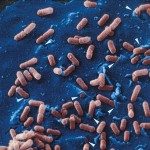Lien vers Pubmed [PMID] – 11571311
J. Cell Biol. 2001 Oct;155(1):101-12
The pathogenic bacterium Listeria monocytogenes is able to invade nonphagocytic cells, an essential feature for its pathogenicity. This induced phagocytosis process requires tightly regulated steps of actin polymerization and depolymerization. Here, we investigated how interactions of the invasion protein InlB with mammalian cells control the cytoskeleton during Listeria internalization. By fluorescence microscopy and transfection experiments, we show that the actin-nucleating Arp2/3 complex, the GTPase Rac, LIM kinase (LIMK), and cofilin are key proteins in InlB-induced phagocytosis. Overexpression of LIMK1, which has been shown to phosphorylate and inactivate cofilin, induces accumulation of F-actin beneath entering particles and inhibits internalization. Conversely, inhibition of LIMK’s activity by expressing a dominant negative construct, LIMK1(-), or expression of the constitutively active S3A cofilin mutant induces loss of actin filaments at the phagocytic cup and also inhibits phagocytosis. Interestingly, those constructs similarly affect other actin-based phenomenons, such as InlB-induced membrane ruffling or Listeria comet tail formations. Thus, our data provide evidence for a control of phagocytosis by both activation and deactivation of cofilin. We propose a model in which cofilin is involved in the formation and disruption of the phagocytic cup as a result of its local progressive enrichment.

